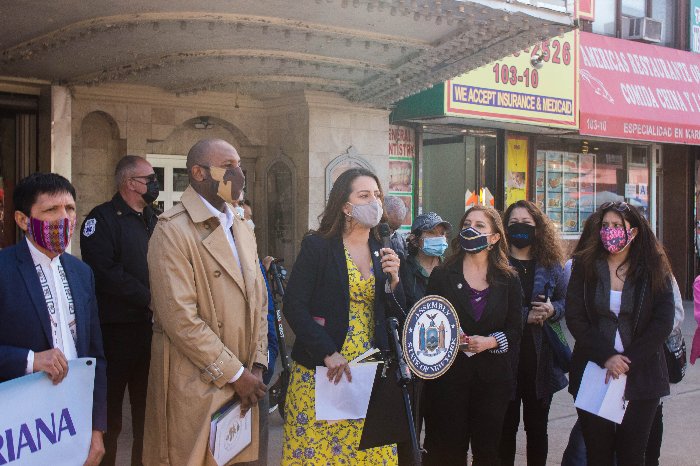
Elected officials hold a rally in Corona Friday to highlight the low vaccination rate among residents (Photo: courtesy of Assemblywoman Cruz)
March 16, 2021 By Christina Santucci (updated)
Corona, the Queens neighborhood once dubbed “the epicenter of the epicenter” of the pandemic, has the lowest COVID-19 vaccination rate in all of New York City.
Assemblymembers Catalina Cruz, Jeffrion Aubry and Jessica González-Rojas held a news conference Friday to highlight the disparity in vaccination rates and to demand better access for Corona residents.
“Our community has been crying out for help since the beginning of the epidemic, and it is patently offensive that we are still forced to beg for basic dignities,” Cruz said in a statement.
The western Queens officials, who were joined by Borough President Donovan Richards and community groups, called on the governor and mayor to add vaccination sites in Corona (zip code 11368), where only 13.6 percent of adults have received at least one dose of the vaccine, according to the city’s health data published Tuesday morning.
Corona’s partial vaccination rate was essentially tied with Hunts Point for the lowest in the entire city.
In comparison, 24 percent of adults boroughwide had gotten at least one shot – and the rates were much higher in several other city zip codes.
For instance, more than 63 percent of adults had received at least one dose in Breezy Point – the highest percentage in the city – followed by over 49 percent of adults in the Upper East Side zip code of 10075 – the second highest.
“There are clear disparities in who has been able to access vaccines,” said Becca Telzak, director of Health Programs at Make the Road New York, in a statement.
She noted that some eligible western Queens residents have struggled to get appointments, lacking the technology needed to get one. Furthermore, some have found the appointment process to be difficult.
The 11368 zip code also had the lowest rate of adults who had been fully vaccinated, at 5 percent, in New York City, according to the data.
Elected officials said that insufficient resources for those with limited English-language proficiency and the small number of vaccine sites in Corona contributed to the disparity. The politicians called for more equity in access.
“The numbers are clear — we need more community vaccination sites and an even more robust outreach effort to reach families in Corona and across the borough,” Richards said in a statement.
There are currently three vaccination sites at pharmacies in the Corona zip code. The zip code has an estimated 83,000 adults – more adults than any other zip code in the city, according to estimates.
Meanwhile, other zip codes have more pharmacy sites and fewer people. For instance, there are four pharmacy vaccination sites in the 10075 zip code, which has an estimated 20,000 adults.
“We know that the residents of this [Corona] zip code have been greatly impacted by COVID-19, and we are looking to add resources to what is currently serving the area,” the city’s Health Department wrote in a statement.
The agency also said that there are two other sites nearby: the Corona Clinic in zip code 11372 and the Citi Field mega vaccine site.
However, a spokesperson for Cruz noted that the stadium was difficult to get to for those with mobility issues. It is also located on the border with Flushing.
Earlier this year, the city made the zip code of 11368 one of its 33 priority neighborhoods for vaccine distribution, but Queens elected officials said they have not seen an added focus on the community as a result of the designation.
The city identified the priority neighborhoods based on factors such as COVID-19 mortality and case rates, the prevalence of overcrowded housing, the number of people experiencing poverty and preexisting health disparities.
“The coronavirus pandemic has decimated our communities of color, our immigrant neighbors and working poor New Yorkers. This is most evident in the neighborhood of Corona the epicenter of the epicenter,” González-Rojas said in a statement.
More than 500 people who lived in the 11368 zip code have died from COVID-19, according to city data.
Al Perna, president of the Corona Community Ambulance, said his father was among the city’s coronavirus victims. He joined the elected officials at the news conference Friday.
“We now have a chance to get everyone vaccinated, and this community doesn’t have enough facilities to give out the COVID shots,” he said in a statement. “Everyone else is getting shots except our community.”
